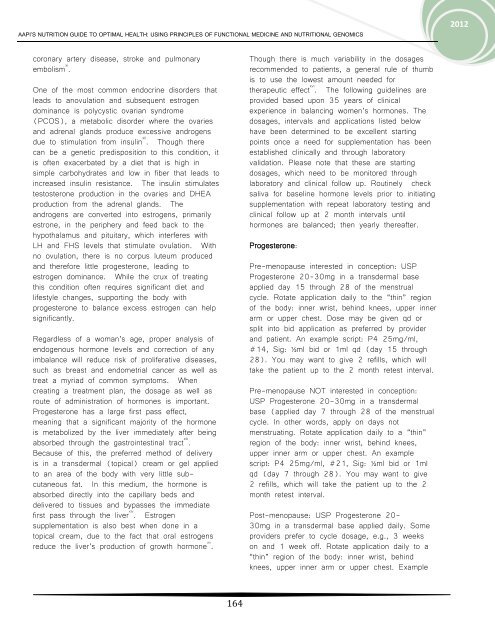functional medicine and nutritional genomics - American Association ...
functional medicine and nutritional genomics - American Association ...
functional medicine and nutritional genomics - American Association ...
Create successful ePaper yourself
Turn your PDF publications into a flip-book with our unique Google optimized e-Paper software.
AAPI’S NUTRITION GUIDE TO OPTIMAL HEALTH: USING PRINCIPLES OF FUNCTIONAL MEDICINE AND NUTRITIONAL GENOMICS<br />
coronary artery disease, stroke <strong>and</strong> pulmonary<br />
embolism xi<br />
.<br />
One of the most common endocrine disorders that<br />
leads to anovulation <strong>and</strong> subsequent estrogen<br />
dominance is polycystic ovarian syndrome<br />
(PCOS), a metabolic disorder where the ovaries<br />
<strong>and</strong> adrenal gl<strong>and</strong>s produce excessive <strong>and</strong>rogens<br />
due to stimulation from insulin xii<br />
. Though there<br />
can be a genetic predisposition to this condition, it<br />
is often exacerbated by a diet that is high in<br />
simple carbohydrates <strong>and</strong> low in fiber that leads to<br />
increased insulin resistance. The insulin stimulates<br />
testosterone production in the ovaries <strong>and</strong> DHEA<br />
production from the adrenal gl<strong>and</strong>s. The<br />
<strong>and</strong>rogens are converted into estrogens, primarily<br />
estrone, in the periphery <strong>and</strong> feed back to the<br />
hypothalamus <strong>and</strong> pituitary, which interferes with<br />
LH <strong>and</strong> FHS levels that stimulate ovulation. With<br />
no ovulation, there is no corpus luteum produced<br />
<strong>and</strong> therefore little progesterone, leading to<br />
estrogen dominance. While the crux of treating<br />
this condition often requires significant diet <strong>and</strong><br />
lifestyle changes, supporting the body with<br />
progesterone to balance excess estrogen can help<br />
significantly.<br />
Regardless of a woman’s age, proper analysis of<br />
endogenous hormone levels <strong>and</strong> correction of any<br />
imbalance will reduce risk of proliferative diseases,<br />
such as breast <strong>and</strong> endometrial cancer as well as<br />
treat a myriad of common symptoms. When<br />
creating a treatment plan, the dosage as well as<br />
route of administration of hormones is important.<br />
Progesterone has a large first pass effect,<br />
meaning that a significant majority of the hormone<br />
is metabolized by the liver immediately after being<br />
absorbed through the gastrointestinal tract xiii<br />
.<br />
Because of this, the preferred method of delivery<br />
is in a transdermal (topical) cream or gel applied<br />
to an area of the body with very little subcutaneous<br />
fat. In this medium, the hormone is<br />
absorbed directly into the capillary beds <strong>and</strong><br />
delivered to tissues <strong>and</strong> bypasses the immediate<br />
first pass through the liver xiv . Estrogen<br />
supplementation is also best when done in a<br />
topical cream, due to the fact that oral estrogens<br />
reduce the liver’s production of growth hormone xv .<br />
164<br />
Though there is much variability in the dosages<br />
recommended to patients, a general rule of thumb<br />
is to use the lowest amount needed for<br />
therapeutic effect xvi<br />
. The following guidelines are<br />
provided based upon 35 years of clinical<br />
experience in balancing women’s hormones. The<br />
dosages, intervals <strong>and</strong> applications listed below<br />
have been determined to be excellent starting<br />
points once a need for supplementation has been<br />
established clinically <strong>and</strong> through laboratory<br />
validation. Please note that these are starting<br />
dosages, which need to be monitored through<br />
laboratory <strong>and</strong> clinical follow up. Routinely check<br />
saliva for baseline hormone levels prior to initiating<br />
supplementation with repeat laboratory testing <strong>and</strong><br />
clinical follow up at 2 month intervals until<br />
hormones are balanced; then yearly thereafter.<br />
Progesterone:<br />
Pre-menopause interested in conception: USP<br />
Progesterone 20-30mg in a transdermal base<br />
applied day 15 through 28 of the menstrual<br />
cycle. Rotate application daily to the ‚thin‛ region<br />
of the body: inner wrist, behind knees, upper inner<br />
arm or upper chest. Dose may be given qd or<br />
split into bid application as preferred by provider<br />
<strong>and</strong> patient. An example script: P4 25mg/ml,<br />
#14, Sig: ½ml bid or 1ml qd (day 15 through<br />
28). You may want to give 2 refills, which will<br />
take the patient up to the 2 month retest interval.<br />
Pre-menopause NOT interested in conception:<br />
USP Progesterone 20-30mg in a transdermal<br />
base (applied day 7 through 28 of the menstrual<br />
cycle. In other words, apply on days not<br />
menstruating. Rotate application daily to a ‚thin‛<br />
region of the body: inner wrist, behind knees,<br />
upper inner arm or upper chest. An example<br />
script: P4 25mg/ml, #21, Sig: ½ml bid or 1ml<br />
qd (day 7 through 28). You may want to give<br />
2 refills, which will take the patient up to the 2<br />
month retest interval.<br />
Post-menopause: USP Progesterone 20-<br />
30mg in a transdermal base applied daily. Some<br />
providers prefer to cycle dosage, e.g., 3 weeks<br />
on <strong>and</strong> 1 week off. Rotate application daily to a<br />
‚thin‛ region of the body: inner wrist, behind<br />
knees, upper inner arm or upper chest. Example<br />
2012

















